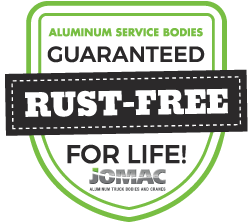
GVWR stands for gross vehicle weight rating, but what does it mean for you and your service truck?
Let’s start with how the GVWR of the truck will determine how many bells, whistles, cranes, tool boxes, and panda bears you will be able to haul on your truck body.
To break it down in a simplified fashion, the GVWR of your truck is the total amount of weight that the vehicle can handle.
GVWR and “curb weight” or empty weight are completely different and it is important to be aware of these differences when selecting a service truck body, and service truck accessories.
Let’s look at the differences…
CURB WEIGHT
The curb weight is often confused with the GVWR, but it is by no means the same figure.
A curb weight will refer to the weight of the truck that has no cargo.
To reiterate, the curb weight is an empty truck, with no passengers, add-ons, etc.
The curb weight includes fuel and fluids, but no added weight from people, accessories, truck caps, cranes, circus clowns, etc.
The curb weight is not going to determine the amount of weight that the truck can handle when loaded, but it will have some influence. This figure will not be as crucial as the GVWR when it comes to selecting the right truck to build a service or utility body upon.
GVWR
By contrast, the GVWR will be a key indicator as to what sort of truck you will need for a body to be built upon, along with what accessories can be added.
The GVWR suggests how much total weight the truck can handle without being overloaded, causing massive issues with the vehicle.
Again, the GVWR refers to the total weight the vehicle can pull. This includes passengers, tool boxes, cinder blocks, cranes, and rocket ships.
How this relates to service truck bodies
When selecting a truck to mount a service or utility body, it is important to know both the curb weight and GVWR to ensure that you are selecting the right vehicle for your workload.
For example, let’s discuss the Ford F-250.
The curb weight of such a vehicle will be between 5,700-6,700 lbs. This is a rough estimate, but it serves as an applicable example.
On the contrary, the GVWR of the same Ford F-250 is typically around 10,000 lbs.
Using simple math (or in my case a calculator, because I did not pay attention in class, ever) we can predict that with a Ford F-250 we will have between 3,300 to 4,300 lbs of wiggle room between the curb weight and GVWR.
This is crucial when designing a service truck to fit your specific needs, as you will be able to accurately predict what sort of vehicle to mount a utility body, crane, and other accessories atop.
Selecting the right vehicle for your needs
When it comes down to it, you need to know what you will be hauling and what your workload looks like. Knowing the GVWR and curb weight of your desired vehicle will help you make a more informed and a more accurate decision.
If you plan to install a crane or any other features that will significantly increase the empty weight of the truck, you may need to opt for a larger vehicle model with a higher GVWR.










